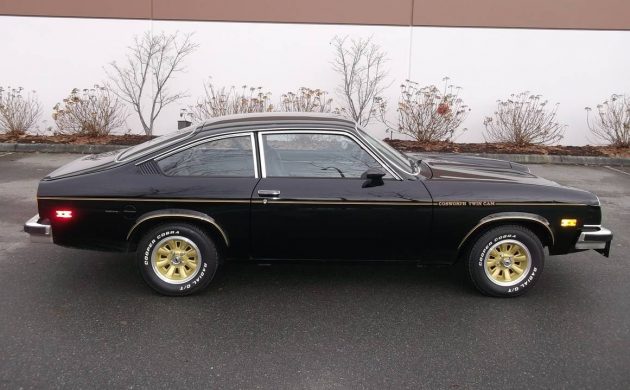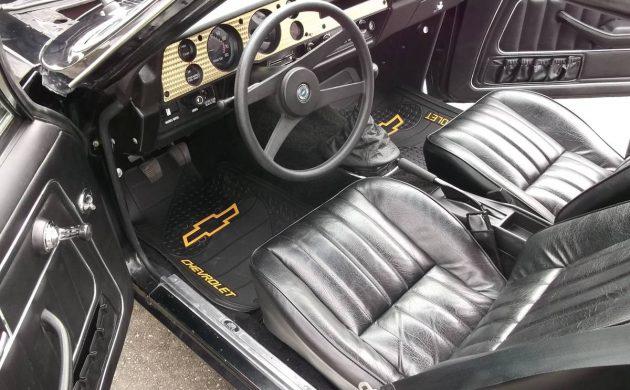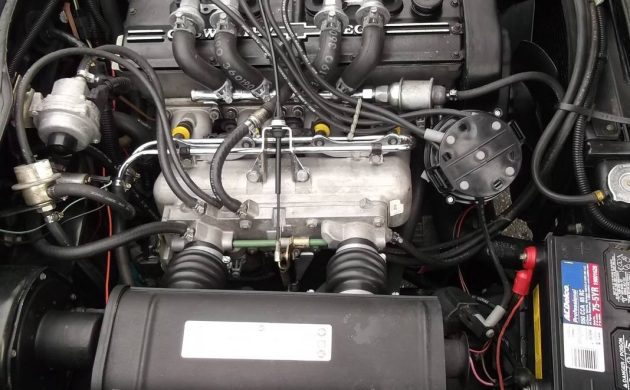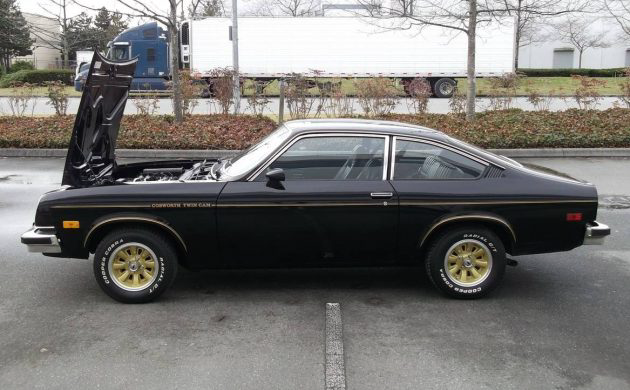Before I began to write for Barn Finds I was voracious reader of every article (and I still am). The reader comments that followed every Cosworth Vega article were always interesting. The Cosworth Vega seems to be a car that polarizes opinions. There really doesn’t seem to be a middle ground. This particular Vega was referred to us by Barn Finds reader Michael and we appreciate his contribution. For sale here on Craigslist with a clean title and located in North Delta, British Columbia, the seller is firm on their price of $15,900.
This particular car looks to be in good condition. I’ve examined the photos closely and everything appears to be in great shape. The seller states that the paint is original and also states that the car is registered with the Cosworth association in America. I assume that he means the Cosworth Vega Owners Association, which holds a registry of these little cars.
The interior appears to be in pretty good shape, and once again the seller claims original status for it. The seats are finished in the standard grained vinyl. There appears to be some stretching of the vinyl on the driver’s seat and there also appears to be some minor wear on both the brake and clutch pedals, but apart from that it looks pretty nice. You really have to love that machine turned instrument fascia.
This is the heart of what set the Cosworth apart from the standard Vega. Reading up on the history of these little 122ci engines is quite interesting. There was a lot of time and effort that went into the development and building of these. To me what is really sad about the history of these engines was the fact that Chevrolet actually built 5,000 of them. Only 3,508 found their way into cars over the 1975/76 model years before the model was discontinued. Chevrolet dismantled about 500 of them and then scrapped the rest. This one looks really tidy. The engine bay is clean and nothing looks obviously out of place although I think that there might be additional wires hooked to the battery terminal (someone correct me if I’m wrong).
So now to the big question, and that is the price. At $15,900 it is not cheap. Searching online reveals cars as low as $7,950 up to as much as $23,000. There was no indication of the mileage on the cheapest car, but the more expensive example had about half the claimed mileage of this one. As I said at the beginning, the Vega Cosworth seems to be a car that people seem to either love or hate. I like the look of them, but I’ve never had to live with one. Have I been lucky or unlucky?






I had no idea so many of these units survived.
$15,900 cdn ~ $11,500 us. A better deal for our neighbors down south.
I love them. Neat cars.
Nice little car and as far as the price goes: don’t forget that’s $15,900 Canadian dollars which is about $18 US Dollars.
Reverse your math, $12,225 US, not a bad deal IMHO!
It was actually a joke about the sad exchange we Canadians get when we buy US $. Believe me, I know how to convert from one to the other and it’s painful every time!
I think 15,900 cad comes out to $12,227.23 usd at the current exchange rate. Still more than I would want to put into it, but that’s just me.
Beaudog, got backwards $11,500 American.
Wrong execution of the right idea, like so many cars throughout the decades.
One in Fla with a more realistic seller. Its has 55000 miles and a buy it now at 6500.00 I hadnt owned one but I did drive one in 1977 with less then 12000 miles I ended up buying a 70 W30 Olds. No real performance to these Vegas.
Just an expensive turd with a hard candy coating. Bite into it, and all you’ll get is a mouthful of turd.
Darn nice little car! I am unsure about that asking price! Seems a little high to me! Then I am not a expert on these!
It’s nice to see that those Avon Safety wheels were used on another car. They were also fitted to the 2.3 litre Vauxhall Firenza HSR from Britain.
Despite both being GM products of about the same size, they were the only common part shared between the two cars.
Stylish little car!
Did the extra litre of displacement (over the Vega) translate to higher performance?
0-60 9.8 sec, top speed 123 mph.So slower 0-60 but about the same top speed. https://www.pistonheads.com/gassing/topic.asp?h=0&f=23&t=1166325
The Vega Cosworth had a 122 c.i.(2.0 litre ) engine, the big Vauxhall four was 2.3 litres, so only 300cc bigger, but 2.5 and 2.7 litre big bore versions of the engine were available. The standard Vega’s capacity was 2.3 litres, the same.
The Cosworth’s smaller capacity came about in a desire to have an internationally homologated engine for the 2 litre class. Cosworth themselves used the engine with some success in Formula 2
There can’t be many of these left. I have seen only two Vegas in the past few years at cruises/car shows, one of them being a Cosworth while the other had a SBC transplanted in it. In 1975, I bought a new “brother under the skin” Monza 2+2 with the 262 V-8 in it. It was sporty, but poorly put together and was traded for an 80 Ford Fairmount wagon in 82.
Cosworth still makes off the shelf 2.O Liter race engines, depending on specs current ones typical 205hp to 285 hp, and at one point they had a 1.6 twin turbo for F1 that made 1000 hp, They are more commonly associated with Ford and work with them on all kinds of projects including some serious 4 banger production cars (mostly for Europe).
But the Chevy Cosworth was no slouch and power to weight was impressive for that time for a car sold to the public. Power could be boosted considerably with off the shelf parts, but part of the reason so few were made was stringent US EPA/DEQ testing and forced them to pass a 50,000 mile test before sold to the public, delaying the program for a year.
See: http://www.oldcarsweekly.com/features/cosworth-vega
” In August 1973, major car magazines reported that Cosworth would team with Chevy to make 5,000 special ’74 Vegas. These cars wore consecutively numbered dashboard plaques for identification.
But the Cosworth package was much more than a plaque. It included twin camshafts and four valves per cylinder. The cams were hidden below covers with the Chevy bow tie, and the Cosworth and Vega names. They helped to boost performance to 140 hp at 7000 rpm. In fact, the hot 2.0-liter four produced 1.15 hp per cube. The torque rating was 105 ft.-lbs. of torque at 6000 rpm.
There were other upgrades as well. The engine was constructed totally of aluminum and weighed only 305 lbs. The special crankshaft was a hardened, tuftrided, forged unit. All of the con rods were forged, shot peened and magnafluxed. The special forged aluminum pistons had deep-dish tops to provide clearance for the valves. A higher-than-stock 8.5:1 compression ratio was used. The 16-valve cross-flow head differed from Cosworth’s racecar version only in having cast combustion chambers and a different type of valve seat design.
The Cosworth suspension had stiffer springs and shocks and a torque-tube type rear suspension, developed for the Monza, was used. Mag wheels and fat tires set the package off. The cars were done in a distinctive Black finish with gold wheels and gold striping. Interior features included a gold-tone engine-turned dash panel and special instrumentation.”
——————————————-
I believe you can find tuning and performance specs to get to race car levels of performance in period Bowtie Power secrets books, sold thru Chevy dealers. I have a collection of various years of these and amazing technical articles on optimizing and performance. (& Blueprinting)
A much less flattering dissection of Bad decisions and bad mgmt at GM covers the history of the detroit compacts and subcompacts and spans the corvair thru vega, chevette and sh*t boxs in general. Fun factoid the Vega name tested poorly with consumers, but mgmt wanted it, The best name was “Gemini” and was popular both in & out of GM.
See: https://ateupwithmotor.com/model-histories/chevrolet-vega-cosworth/
” In the spring of 1972, DeLorean got Ed Cole and Corvette chief engineer Zora Arkus-Duntov to drive a prototype of Wade’s super-Vega and secured approval for an initial run of 5,000 cars.”
It was about then that the trouble began. Cosworth hit the wall in its efforts to produce a viable racing version of the Vega. The standard aluminum block castings turned out to have a safe limit of 270 hp (201 kW), 20–30 hp (15–22 kW) shy of what a Formula 2 version of the Chevrolet engine would need. (By this time, Cosworth’s Ford-based BDA twin-cam engine was making around 240 hp (179 kW) in Group 2 rally tune.) The only solution was to make extensive changes to the Chevrolet’s block casting process, which the Massena engine plant was neither able nor willing to undertake; Cosworth finally gave up in the spring of 1973.
Meanwhile, Chevrolet’s street version, originally slated for a mid-1973 introduction, was running behind schedule. Wade had hoped for 185 hp (138 kW) in street form, but noise and emissions regulations made that impossible. ven at 130–140 net horsepower (97–104 kW), he and McPherson were still not sure the twin-cam engine could pass the EPA’s 50,000-mile (80,000-km) durability test. (McPherson, for his part, maintained that the whole project was a hopeless boondoggle.) They finally opted to delay emissions certification rather than risk failing the time-consuming durability test and having to start over.
I have owned two, a ’75 4 speed and 76 5 speed……..nice collectors car…………. but anemic….. especially for what it cost.
Never owned one but I had the pleasure of a brief drive in the late ’70’s and it was an impressive ride. A bit more than adequate acceleration, but for an American car of the time, incredible handling. Tight, fast, and fun on a winding road!